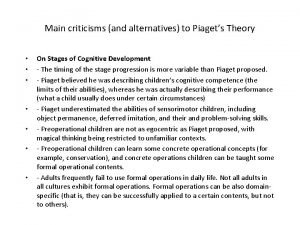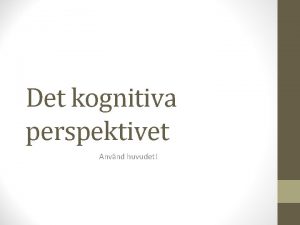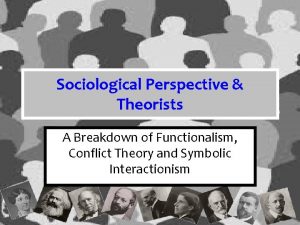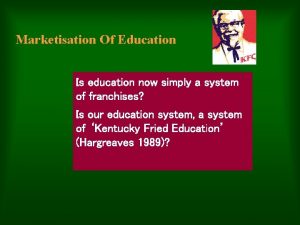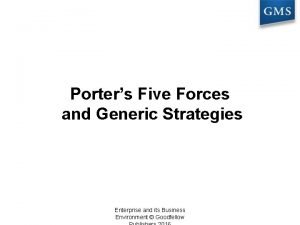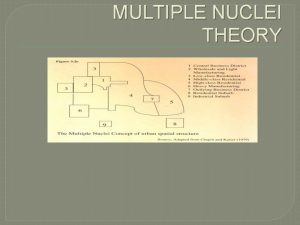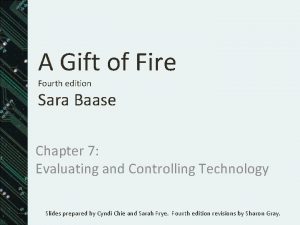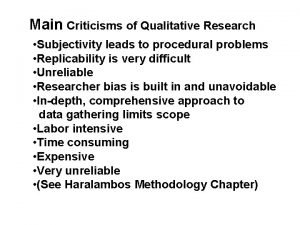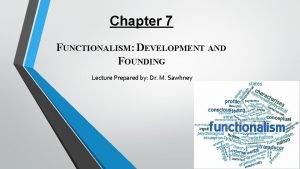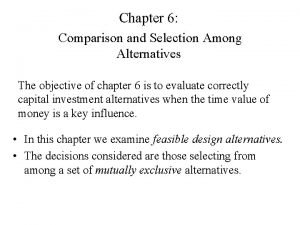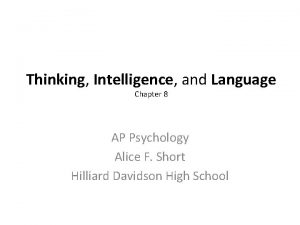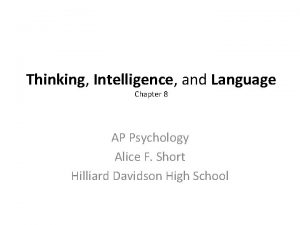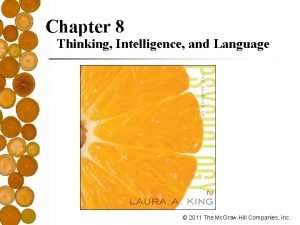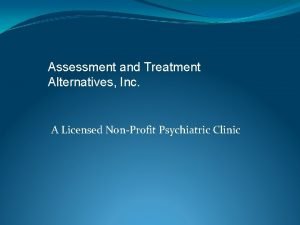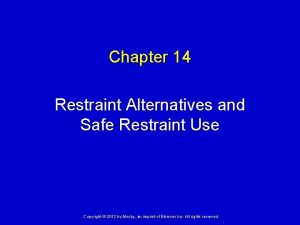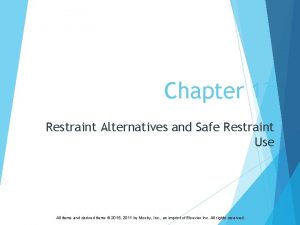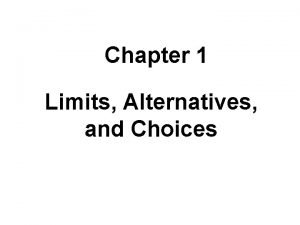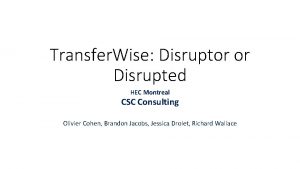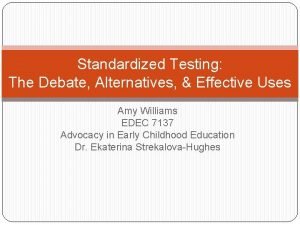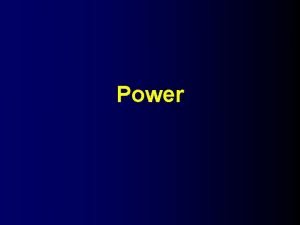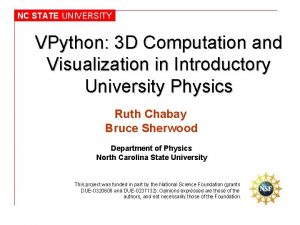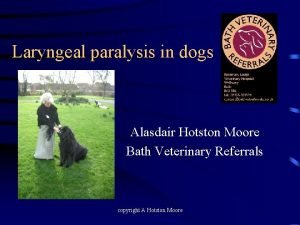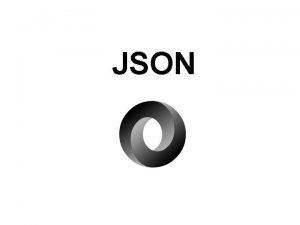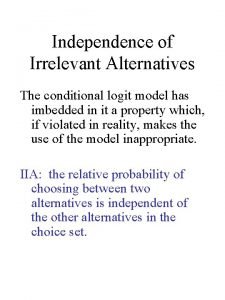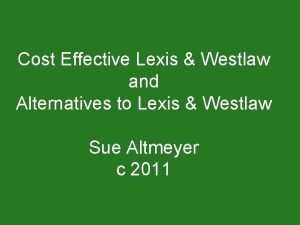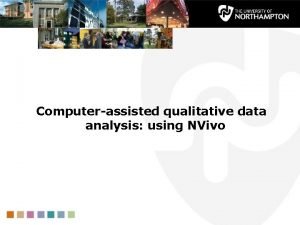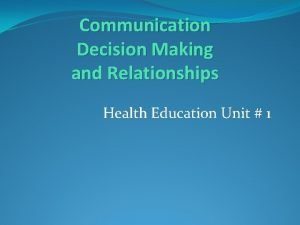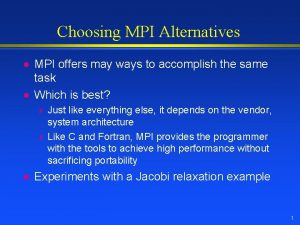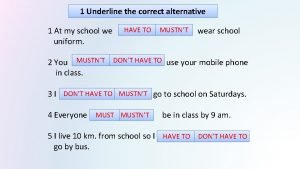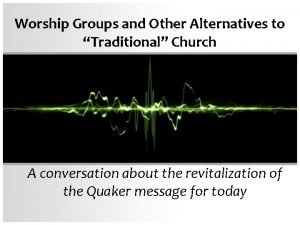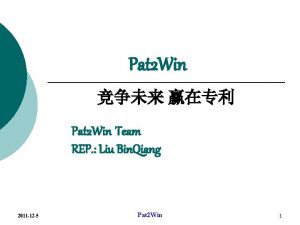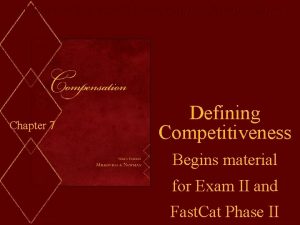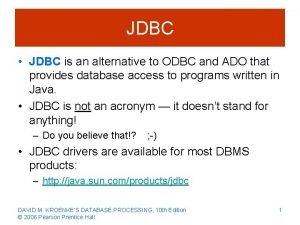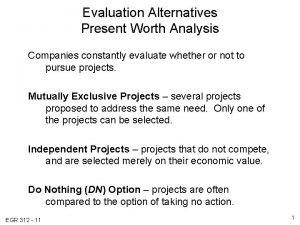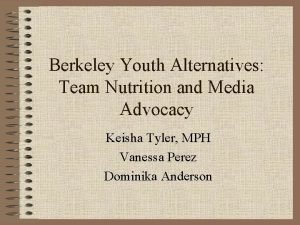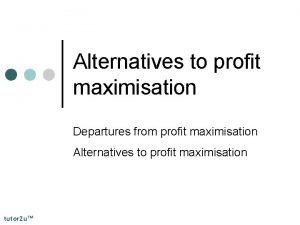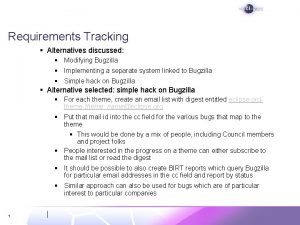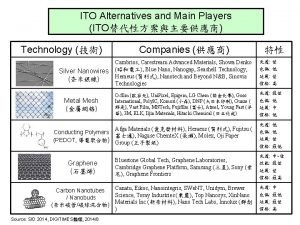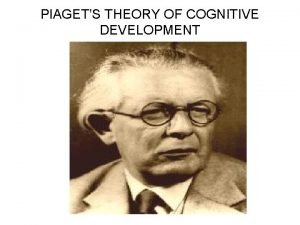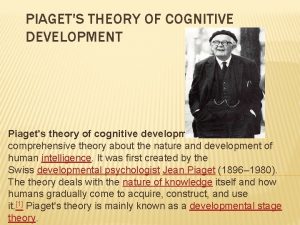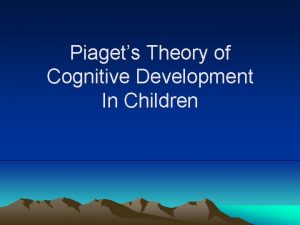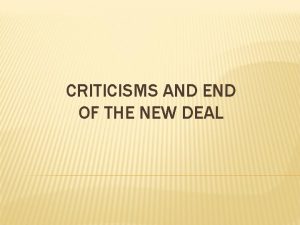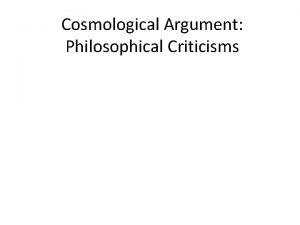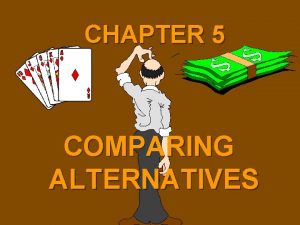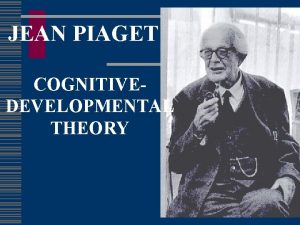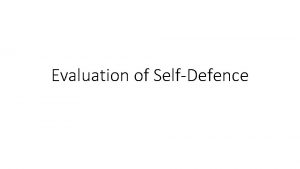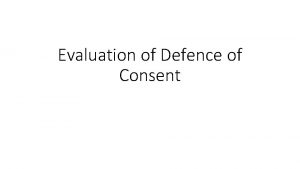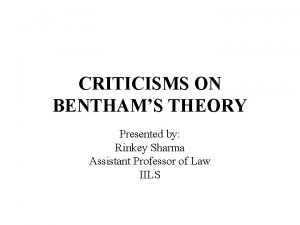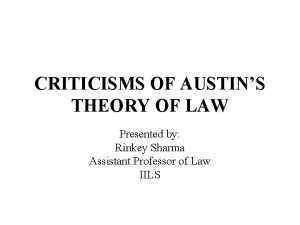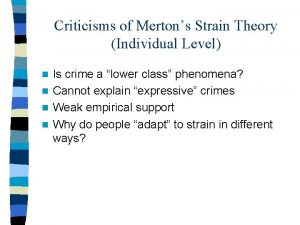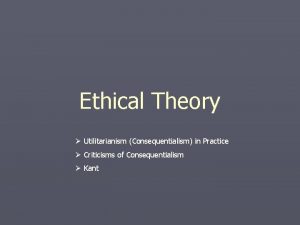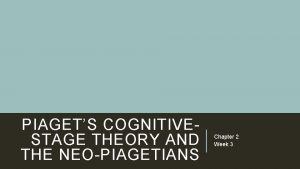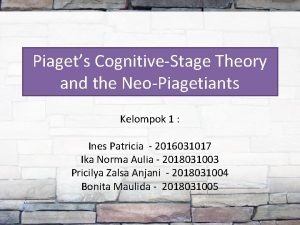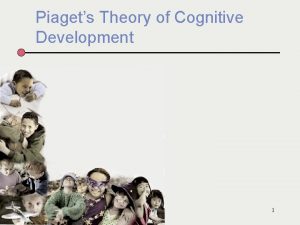Main criticisms and alternatives to Piagets Theory On



























































- Slides: 59

Main criticisms (and alternatives) to Piaget’s Theory • • On Stages of Cognitive Development - The timing of the stage progression is more variable than Piaget proposed. - Piaget believed he was describing children’s cognitive competence (the limits of their abilities), whereas he was actually describing their performance (what a child usually does under certain circumstances) - Piaget underestimated the abilities of sensorimotor children, including object permanence, deferred imitation, and their and problem-solving skills. - Preoperational children are not as egocentric as Piaget proposed, with magical thinking being restricted to unfamiliar contexts. - Preoperational children can learn some concrete operational concepts (for example, conservation), and concrete operations children can be taught some formal operational contents. - Adults frequently fail to use formal operations in daily life. Not all adults in all cultures exhibit formal operations. Formal operations can be also domainspecific (that is, they can be successfully applied to a certain contents, but not to others).

Main criticisms (and alternatives) to Piaget’s Theory • • • On Mechanisms of Cognitive Development - “stage” is not a worthy concept; many scientists think there is no real proof they actually exist, at least as described by in Piaget (Information-processing approaches) - “stage” can be a useful concept if used more liberally than Piaget did (Neo. Piagetian Theories) - social environment and culture play a more significant and crucial role than Piaget proposed (Sociocultural Approach) - evolved dispositions play a more significant role in early development than Piaget proposed (Theory Theories, and Core Knowledge Approaches)

Memory Development


Memory Development in Infancy • Novelty preference • Conjugate reinforcement procedure • Deferred imitation

Apparatus used by Rovee-Collier et al.

Conjugate Reinforcement Procedures • Baseline kicking rate (3 minutes, unattached to apparatus • Reinforcement period (9 minutes, ribbon attached to apparatus) • Delay • Test period (unattached to apparatus)

Maximum duration of retention from 2 to 18 months (from Rovee-Collier, 1999)

Deferred-Imitation Procedure • Demonstration of novel actions on objects – Touching box with head to turn on light (Meltzoff) – Placing bar across two posts, hang plate from bar, strike bar with mallet (Bauer et al. ) • Delay • Test

The “gong” task. Infants watched as a model performed a three-step sequence: placing the bar across two posts, hanging a plate on the bar, and striking the plate with a mallet. Infants were later given the opportunity to reproduce the sequence, demonstrating evidence of deferred imitation, and thus memory

Percentage of 13 -, 16 -, and 20 -month-old infants displaying deferred imitation of three-step sequences as a function of length of delay (from Bauer et al. , 2000)

Is deferred imitation a form of explicit memory? • Mc. Donough et al. (1995) tested patients with amnesia on deferred-imitation task • Baseline • Demonstration • Delayed test • Various control groups

Mean number of actions correct (Max = 12) by group (from Mc. Donough et al. , 1995)

The Development of Event Memory

Infantile Amnesia • Freud’s repression hypothesis

Are infant memories repressed?

Infantile Amnesia • Storage failure • Encoding differences – Later memory related to abilities at time of event, not time of testing (Simcock & Hayne, 2002) • “Children’s verbal reports were frozen in time, reflecting their verbal skills at the time of encoding, rather than at the time of test” • Sense of self • Use of language in social interactions

Infantile Amnesia and Hypnotic Age Regression • Adults asked to perform conservation tasks (Nash, 1987) • Group 1: Age-regressed to 4 -years of age • Group 2: Pretend you’re a 4 -year old • Neither perform like real 4 -year olds • Regressed adults perform like adults who are pretending to be 4 -years old

The Role of Parents in “Teaching” Children to Remember

Children as Eyewitnesses

Three major interacting classes of variable in interpreting children’s eyewitness memory and suggestibility (from Lindberg, 1991)

Age Differences in Eyewitness Memory • For open-ended, free-recall questions, young children recall less than older children, but what they recall is usually central to the event and accurate • Correct and incorrect recall increases in cued-recall questions, reducing accuracy • Amount and accuracy of memory related to: – Length of delay – IQ – Level of stress – Interviewer characteristics – Knowledge

Age Differences in Suggestibility • Responses to leading questions • False-memory creation

Percentage correct and incorrect responses by age to misleading questions (from Cassel & Bjorklund, 1995)

Percentage correct and incorrect responses by age to positiveleading questions (from Cassel & Bjorklund, 1995)

Percentage of false reports over sessions for 3/4 -year olds and 5/6 -year olds (from Ceci et al. , 1994)

Factors influencing false-memory creation • Plausibility (Pezdek & Hodge, 1999)

Believing rumors: Magic Mumfrey and his disappearing bunny(Principle et al. , 2010) • 3 -4 year olds + 5 -6 -year olds • Watch a magic show, in which Magic Mumfrey fails to pull a rabbit out of his hat. • Some children overhear one teacher telling another “The rabbit got loose and was in the classroom. ” Others heard rumor only from classmates. • Interviewed 1 week later. Some warned about false rumor, others not: – Overheard (from teacher)/not warned – Overheard (from teacher)/warned – Classmate/not warned – Classmate/warned – Control children

Proportions of Children Who Reported Actually Seeing the Target Activity with Their Own Eyes (Principle et al. , 2010)

Sequence of phases recommended by the NICHD guidelines • • • • 1. 2. Introduction of parties and their roles The “truth and lie ceremony” (warning the child of the necessity to tell the truth) 3. Rapport building 4. Description of a recent salient event 5. First narrative account of the allegation 6. Narrative accounts of the last incident (if the child reports multiple incidents) 7. Cue question (for example, “You said something about a barn. Tell me about that. ”) 8. Paired direct-open questions about the last incident 9. Narrative account of first incident 10. Cue questions 11. Paired direct-open questions about the first incident 12. Narrative accounts of another incident that the child remembers 13. Cue questions 14. Paired direct-open questions about this incident 15. If necessary, leading questions about forensically important details not mentioned by the child 16. Invitation for any other information the child wants to mention

Prospective Memory (Mental time travel) • Remembering to do something in the future • Somerville and her colleagues (1983): “Naturalistic” study – Parents remind 2 -, 3 -, and 4 -year-olds to remind them to perform some task in the future – Low interest (“Remind me to buy milk when we go to the store tomorrow”) – High interest (“Remind me to buy candy when we go to the store tomorrow”) – Short delays (5 minutes or less) – Long delays (later in the day; tomorrow)

Proportion of children who reminded their parents to perform some task for 2, 3 -, and 4 -year-old children for high- and lowinterest tasks over short and long delays

Cyber. Cruiser (Kerns, 2000) • 7 - to 12 -year-old children played a computer game called Cyber. Cruiser in which they used a joystick to maneuver around obstacles. • Children also had to occasionally check the fuel gauge to make sure they did not run out of gas and to fill up when they had less than a quarter tank.

Average number of times children ran out of gas playing Cyber. Cruiser by age (Kerns, 2000).

What is Language? • Human language is: • Symbolic: The sounds of spoken language or the hand movements of sign language represent something independent of the actual sounds or movements • Grammatical: Language has a system of rules that permits a speaker to produce and understand sentences that have never been uttered before. – Morphology – Syntax • Although all biologically-typical people acquire language, the particular language children learn to speak varies with culture.

Seven functions of language according to M. A. K. Halliday (1973) • Instrumental: Using language to express needs (for example, “More milk”) • Regulatory: Using language to tell others what to do (for example, “Get me juice”) • Interactional: Using language to make contact with others and form relationships (for example, “I love you, mommy”) • Personal: Using language to express feelings, opinions, and individual identity (for example, I’m a good boy”) • Heuristic: Using language to gain knowledge about the environment (for example, “What’s that? ”) • Imaginative: Using language to tell stories and jokes, and to create an imaginary environment. • Representational: Using language to convey facts and information.

Describing Children’s Language Development • Receptive language > productive language • Early language is telegraphic • Phonological development – Babbling • Morphological development – – – Morpheme Free morphemes vs. bound morphemes Mean length of utterance (MLU) Overregularization Wug test

Two examples from the “wug” test (Berko, 1958).

Major milestones in early language development. “Lexicon” refers to the words that a child knows (semantics), and “communication” refers to a child’s ability to use language in social situations (pragmatics).

Syntactic Development • • Negatives Questions Passives Relating events in sentences

Semantic Development • Word spurt productive vocabulary – Productive vocabulary: 22 -37 mos. – Receptive vocabulary: 12 -17 mos.

Different children show different times of onset of their growth spurt

Semantic Development • Constraints on word learning – Whole-object assmuption – Taxonomic assumption – Mutual exclusivity assumption • Overextentions • Underextensions

Nativist Perspective on Language Development • Noam Chomsky – Surface vs. deep structure – Generative grammar – Language acquisition device (LAD) – Universal Grammar

Eric Lenneberg • Language is • • • Species specific Species uniform Difficult to retard Develops in a regular sequence Has specific anatomical structures Associated with genetically-related disabilities

Universal Grammar • All languages have: • Extensive vocabularies divided into different parts-of-speech categories • Words organized into phrases following similar rule structure (X-bar system) • All permit movement of grammatical categories • All use suffixes and prefixes

Pidgins and Creoles • Pidgins: not a true language • Creoles: a true language created by children of pidgin speakers, often in one generation • Senghas & Coppola – Development of Nicaraguan Sign Language

This figure shows two views of the left hemisphere. Figure A shows possible networks for various language functions. Figure B shows the grammar center and other areas involved in language, as proposed by Sakai (2005). The green area is selectively involved in comprehending sentences. The red areas are specifically involved in syntactic processing and can be regarded as the grammar center (from Sakai, 2005, p. 817).

Is there a critical period for learning language? • Social deprivation (feral children) • First-language learning of deaf people – Newport: Proficiency in ASL as function of age of exposure • Recovery of function after brain damage • Second-language learning – Johnson & Newport: proficiency in English as function of age of arrival in U. S.

The relationship between age at arrival in the United States and total number of correct answers on a test of English grammar (data from Johnson & Newport, 1989

Bilingual speakers made grammatical judgments in their second language. For adults who were highly proficient in both languages (A), different parts of the brain were involved in making grammatical judgments for those who learned their second language late (LAHP) versus those who learned their second language early (EAHP). When considering people only who learned their second language late, different areas of the brain were involved for people with high- versus low-language proficiency in their second language (B) (from Wartenburger et al. , 2003).

“Less is More” Hypothesis • Limitations in infancy may be adaptive to later learning (Turkewitz & Kenny) • Newport • Elman (“The importance of starting small”)

Social-Interactionist Perspectives of Language Development • Social-pragmatic view: “Children’s initial skills of linguistic communication are a natural outgrowth of their emerging understanding of other persons as intentioal agents” (Carpenter et al. , 1998)

From gestures to speech • Gestures (pointing) as form of shared attention • The more children used gestures at 14 months of age, the larger their vocabularies were 54 months. (Rowe & Goldin-Meadow, 2009). • Gesture-facilitation hypothesis, arguing that the use of gestures facilitates the acquisition of spoken language. • The relation between gestures and language development was investigated in a longitudinal study that followed children between 10 - and 14 -months of age (Iverson & Goldin-Meadow, 2005). Looked at items(gestures or speech) that were: – – initially (a) identified in speech and stayed in speech; (b) identified in gesture and stayed in gesture; (c) identified in speech and transferred to gesture; and (d) identified in gesture and transferred to speech

Proportion of objects children learned to identify by speech or gesture that either remained within the original modality (speech to speech or gesture to gesture) or transferred to the other modality (speech to gesture of gesture to speech). Children were much more likely to acquire a new gestures and transfer it to speech than vice versa, supporting the gesture-facilitation hypothesis (from Iverson, & Goldin. Meadow, 2005).

Child-Directed Speech • AKA: infant-directed speech (IDS); motherese; parentese • Language acquisition support system (LASS, Bruner) • Prosodic features of IDS – Higher acoustic frequency – Wider range of frequencies – Greater incidence of rising countours • Short, grammatical sentences

Child-Directed Speech • Used across cultures (in varying degrees) • Infants more attentive to adults using IDS as opposed to adult-directed (AD) speech (Cooper & Aslin, 1990; 1994) • Mothers of deaf children use exaggerated signs to their infants ad infants are more attentive to I-D signs than A-D signs (Masataka, 1998) • Infants can discriminate sounds better in I-D than A-D speech (Trehub et al. , 1993) • I-D speech used to regulate infant’s behavior and emotions (Fernald, 1992)

Bilingualism • simultaneous bilingualism: children are exposed from birth to two languages. • sequential bilingualism: children learn a second language after mastering their first. • Simultaneous bilingual children often have smaller vocabularies in both languages and a slight delay in syntactic development, but by the age of 8 or so, there are typically no differences between them and monolingual children. • Bilinguals: Better able to recognize a wider of phonemes than monolinguals greater sensitivity toward the cultural values display higher levels of metalinguistic awareness than monolingual children advantage is in terms of executive function, particularly on tasks that demand flexible thinking (also in infancy: Kovács & Mehler, 2009) – Display better theory-of-mind than monolinguals – –

Language and Thought • Piaget: Egocentric speech symptomatic of preoperational thought – Egocentric speech is failed attempt to communicate • Vygotsky: private speech as cognitive self-guidance system that eventually leads to inner speech
 Criticisms of piagets theory
Criticisms of piagets theory Kognitivt schema
Kognitivt schema Mechanical solidarity definition sociology
Mechanical solidarity definition sociology What is vocationalism in sociology
What is vocationalism in sociology Parentocracy david
Parentocracy david Lasting impacts of the new deal
Lasting impacts of the new deal Criticisms of the sick role
Criticisms of the sick role Supplier power picture
Supplier power picture Eternal law examples
Eternal law examples Multiple nuclear theory
Multiple nuclear theory Neo luddite criticisms of computer technology
Neo luddite criticisms of computer technology Subjectivity in qualitative research
Subjectivity in qualitative research Functionalism
Functionalism Criticisms of vocational education
Criticisms of vocational education Tells more about the main idea
Tells more about the main idea Future i will
Future i will Void main int main
Void main int main Comparison and selection among alternatives
Comparison and selection among alternatives Thinking, language and intelligence psychology summary
Thinking, language and intelligence psychology summary Evaluating alternatives and making choices among them
Evaluating alternatives and making choices among them Chapter 8 thinking language and intelligence
Chapter 8 thinking language and intelligence Assessment and treatment alternatives
Assessment and treatment alternatives Restraint alternatives
Restraint alternatives Restraint alternatives are
Restraint alternatives are Methods of comparing alternatives in engineering economy
Methods of comparing alternatives in engineering economy Society's economizing problem involves
Society's economizing problem involves Amy walls
Amy walls In conclusion alternatives
In conclusion alternatives Standardized testing alternatives
Standardized testing alternatives Vertical marketing system
Vertical marketing system Vertex smb alternatives
Vertex smb alternatives In conclusion alternatives
In conclusion alternatives Vpython alternatives
Vpython alternatives Alternatives to surgery for laryngeal paralysis in dogs
Alternatives to surgery for laryngeal paralysis in dogs Json xml alternatives
Json xml alternatives Independent irrelevant alternative
Independent irrelevant alternative Global marketing
Global marketing Implicit service promises examples
Implicit service promises examples Westlaw cost per search
Westlaw cost per search Nvivo alternatives
Nvivo alternatives Explore the alternatives in decision making
Explore the alternatives in decision making Mpi waitall
Mpi waitall Global product planning strategic alternatives
Global product planning strategic alternatives Underline the correct alternatives
Underline the correct alternatives Alternatives to traditional church
Alternatives to traditional church Winpat alternatives
Winpat alternatives What shapes external competitiveness
What shapes external competitiveness Odbc alternative
Odbc alternative Freewrite alternative
Freewrite alternative 9 box mckinsey
9 box mckinsey Capitalized
Capitalized Engineering economy 15th edition
Engineering economy 15th edition The term capacity refers to
The term capacity refers to Berkeley youth alternatives
Berkeley youth alternatives Alternatives to profit maximisation
Alternatives to profit maximisation Alternatives to convolutional neural networks
Alternatives to convolutional neural networks Touch screen alternatives
Touch screen alternatives Ca ppm alternatives
Ca ppm alternatives Bugzilla alternatives
Bugzilla alternatives Ito companies
Ito companies
